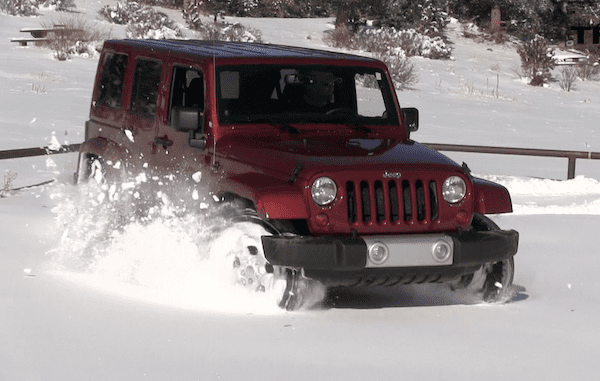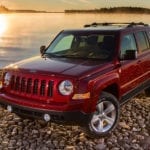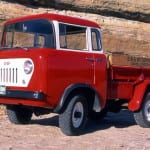If you’re a Jeep owner, you’re a member of an exclusive group of car owners. Those who drive Jeeps love their rides for the vehicle’s unique abilities. Since the Jeep is truly one-of-a-kind, you’ll often see these Jeep owners appreciating or worrying about issues that you’d never think about with your car.
You may hear other drivers complain about their car’s inability to perform a common function, or maybe you’ll hear somebody brag about their vehicle’s great fuel economy. Jeep owners don’t have time for those types of conversations, as they’d prefer to discuss their vehicle’s ability to drive through creeks and feet of snow.
We’ve compiled some of the more interesting and exclusive Jeep features below. Whether you’re considering purchasing a new Wrangler or used Jeep Wrangler Unlimited, you will be itching to start your car search when you’re finishing reading. After all, everyone wants to be included in an exclusive club…
The Ability To Get You Interior Soaked
Whenever someone’s sedan gets flooded, it’s usually an absolute disaster. Replacing an interior can cost thousands of dollars, and water damage can ultimately total a car. It’s no surprise that the Jeep engineers have accounted for this issue, meaning you can drive your Jeep anywhere.
You may think Jeep owners are a bit crazy for keeping their roof open during a torrential downpour. It also seems a bit off that they’re speeding through a multi-foot creek while off-roading. These owners know exactly what they’re doing, and they trust the various water-eliminating features that the company has included in their vehicles.
The main way to get water out of your Jeep is via the drain plugs. With multiple plugged draining holes found throughout the cabin, a driver can simply remove the cap and watch as the entire interior is flushed of water. As an alternative, some drivers have taken the more “natural” route, allowing the sun to dry out their Jeep. Depending on where you live and drive, allowing the elements to dry your car may leave behind some dirt and grime. When it comes down to it, the best way to go about drying your Jeep is doing it manually.
Jeep (and some after-market businesses) have produced a number of water-resistant products to help protect your interior from bad weather. Some of the brand’s seat materials are already engineered with such capabilities, and you’ll sometimes see drivers further protecting themselves by covering the seats with plastic. When it comes to non-upholstery, there’s no reason to worry; the plastic interior won’t wear down due to some water contact. Just make sure you wipe it down the first chance you get.
Of course, the obvious way to prevent water from getting into your Jeep is by keeping on your hard top. To be devil’s advocate, there’s not much fun in that. Luckily, there’s little to no risk in getting some water inside your Jeep (although we wouldn’t suggest practically submerging the vehicle in water), but it’s essential that you don’t flood any of your Jeep’s mechanics. However, if you’re careful with your vehicle, you shouldn’t have any issues with your Jeep getting an occasional shower.
Ability to Drive in Bad Weather
If there’s even a threat of snow or ice, I give up any hope up driving my vehicle and call it an evening. Considering the Jeep’s rugged abilities, there won’t be many weather issues that prevent you from getting on the road. With the vehicle’s four-wheel drive capabilities, strong and durable tires, straps, and an assortment of other features, the Jeep can handle practically any conditions.
Of course, we’re not saying that you should grab your keys and go out driving in the middle of a blizzard. There’s a variety of reasons why’s it dangerous to be driving any vehicle through the snow, and FourWheeler.com explains why Jeeps aren’t an exception. Most tires on Jeeps don’t have siping (which helps improve traction in bad conditions), many drivers don’t utilize their antilock brakes, and the vehicle naturally has a “short wheelbase and a high center of gravity.”
There are plenty of ways that you can go about improving your Jeeps’ driving abilities in harsh weather. FourWheeler.com suggests adding narrower tires, and when the snow has piled up to your vehicle’s axles, you can switch to the “higher flotation tires.” Locking the hubs (which allow the front wheels to be manually discontinued from the front half shafts) and bringing some snow-melting provisions (cat liter works surprisingly well, as does salt) are also good ideas. While it’s unlikely that you’ll end up getting stuck, you can never anticipate sliding into a pile of snow and getting stranded.
When it comes down to it, your safety is of utmost importance, and it’s ultimately determined by how you drive. Sure, the Jeep is better equipped to drive in bad weather compared to other vehicles, but that doesn’t mean you should be testing the limits. The Jeep will certainly keep you safe to an extent, but it won’t prevent you from getting in an accident, especially if you’re driving erratically. If the conditions are bad, it’s a good idea to that assume you’re still driving a small sedan. Take it slow and steady, and you’ll get home safe and sound.
Dealing With the Death Wobble
This Jeep-exclusive “issue” isn’t experienced in any other vehicle (if it did, we’d expect that driver to predictably panic and visit their local mechanic). With the Jeep, the shaking is common in many of the brand’s vehicles, and while the issues may eventually require a look from a mechanic, it’s certainly not as urgent of a repair.
Jeep owners refer to this issue as the “death wobble,” which is when the front of the Jeep appears to shake violently. As JeepProblems.com explains, the death wobble could be a clue that your vehicle’s “suspension system is out of equilibrium,” whether it’s due to unbalanced tires, poor alignment, a loose stabilizer bar or worn out ball joints. New Jeep owners may be skeptical, as similar issues on different vehicles wouldn’t cause the car to shake. However, new owners should also be relieved that the shaking isn’t a far more devastating (and costly) issue.
This shaking happens to Jeeps because of the “coil-spring” design. There are not too many ways around this inevitable issue; those who modified their Jeeps (whether they added after-market track bars or lifted the vehicle) are susceptible to the issue as well. As the website notes, the Cherokee, Grand Cherokee and Wrangler have been the models particularly affected by this issue.
Luckily, there’s a variety of ways you can fix the problem. Once you identify what the problem actually is (JeepProblems.com suggests checking the added after-market track bars, front track bar, damaged steel, broken down tries, and front axle casters, assuming your Jeep has been lifted). Replacing the faulty part should provide a quick and easy fix. If your Jeep continues to shake, visit a mechanic. Just because the issue is common, it doesn’t mean it should be ignored. While the issue should eventually be repaired, there’s no reason to rush to a mechanic following the first indication of a problem.
Considering the Jeep is the premier off-roading vehicle, you have to expect your vehicle to occasionally act a bit erratic. An odd noise could be attributed to faulty brakes, hubs, u-joints, or even the engine. Bizarre noises are commonplace in Jeeps, even when there’s no real problem to fix. In fact, some owners have said that silence could indicate that there’s some kind of issue. After having driven your new vehicle for a while, you should be able to figure out whether the sound can be attributed to an actual problem.
Are you convinced? There’s isn’t a more unique brand of vehicles on the market than Jeep, and owners can expect to do a lot more with their vehicle than others.





